The digital entertainment segment is thriving, creating new opportunities for businesses. For instance, according to We Market Research, Smart TV is projected to reach $451.26 billion with a CAGR of 11.6% by 2033.
As a result, investing in TV application development in 2023 can be a promising venture, offering potential revenue since this industry holds significant potential and is easily monetizable.
Experts at Lampa Software have prepared an extensive guide that explains the peculiarities and advantages of building custom Smart TV apps.
Going through it lets you understand the potential benefits of launching the app development process right now without waiting for changes in the target market.
Smart TV Development
Similar to mobile apps, IT solutions for Smart TVs significantly expand the capabilities of these devices. By providing new features and user-friendly algorithms, they create demand in the market that can be leveraged to your advantage.
All types of applications for televisions can be monetized to varying degrees. Some perform better than others, but they all generate passive income for their owners. Let's briefly go over the main types of such software.
Definition of Smart TV Apps
Smart TV platforms are created on the basis of Linux or Android, which allows you to build applications for them almost without restrictions. For example, the most commonly implemented:

There is a much broader list of potentially possible applications, but for now, we're focusing on those that are used by the potential target audience.
Growing Popularity of Smart TVs
The global TV market was valued at $197.82 billion in 2022 and is expected to double by 2033. Analysts highlight the high demand for expensive OLED models with 4K or higher resolution.
Considering these data points, we can conclude that the industry has potential and can generate revenue for equipment manufacturers and software developers.
Importance of Smart TV App Development
Smart TVs are often used not just for cable or satellite television but for their Internet connectivity, which matters to the target audience.
What kind of visual entertainment does the typical owner of a large TV screen enjoy? Most likely, watching movies and TV shows in the highest quality. They usually install platforms like Netflix, through which they consume almost 100% of their content.
That's why the potential of building a high-quality Smart TV app is nearly limitless, especially when carefully selecting the app type, target audience, and IT product features.
Key Considerations for Smart TV App Development
Both the Covid-19 pandemic and technological progress, which led to a decrease in the cost of Smart TV models, have contributed to the increased demand for these devices.
Moreover, the ability to install programs that significantly expand platform functionality has further propelled the industry's growth.
While Smart TV app development is a great idea overall, it's essential to prepare in advance for effective implementation and monetization. Lampa Software experts have compiled a guide to help you define the critical development direction, ensuring the release of a valuable and useful IT solution.
Target Audience Analysis
You must identify the most financially capable and loyal audience to create truly effective and monetizable software.
Demographics and User Behavior
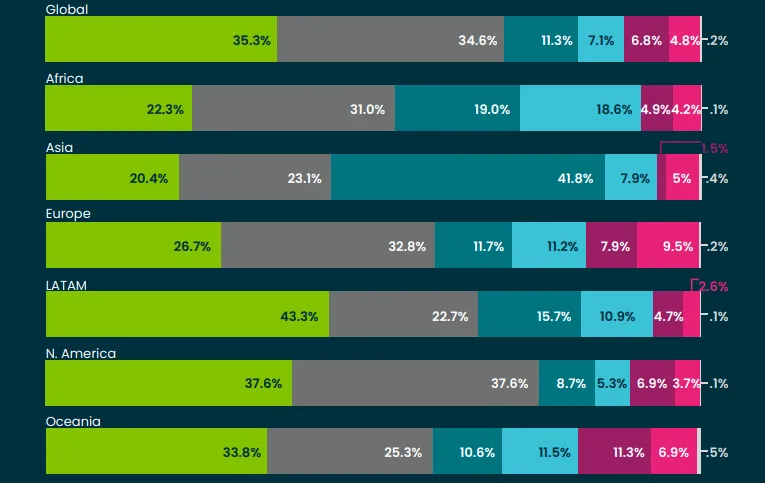
First and foremost, determine which market you plan to target: Asia, India, Europe, the USA, or Africa. Each region has its own peculiarities and popularity levels for Smart TV among different social and age groups.
Understanding this will help you properly tailor your product and focus on a specific user category.
Preferences and Content Consumption Patterns
Consider scenarios like streaming TV, digital content consumption, or even gaming directly on TVs. Each app usage scenario requires personalized implementation, so it's crucial to identify what interests your target audience the most.
By addressing the needs of potential software users, you can develop a valuable product that can be effectively monetized.
Platform Selection
Just like in other markets, the Smart TV industry is highly competitive among device manufacturers. Each of them limits themselves to their own platforms and technologies, creating ecosystems.
This practice binds users to their systems, which poses certain constraints on software developers. Therefore, a compromise (at least in the initial stages) is essential.
Leading Smart TV Platforms
Every TV manufacturer utilizes its own platform or significantly customized version. As of 2022, the most popular systems on TVs were:
Systems like Linux or its forks were not included in the list since they usually aren't distributed as built-in software but as optional choices for device owners.
Market Share and User Base
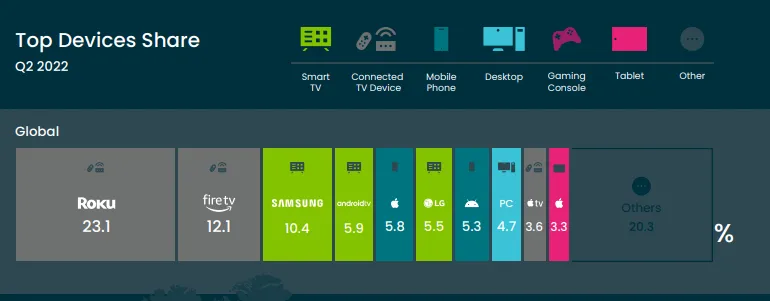
Regarding the market share of each specific platform, the data often varies. Here's an approximate statistic for 2022:
Roku: 23.1%
Fire TV: 12.1%
Samsung TV: 10.4%
Android TV: 5.9%
WEB OS: 5.5%
Apple TV: 3.6%
However, keep in mind that Roku dominates in the USA, while Samsung TV (Tizen OS) is more prevalent in Europe. So, first and foremost, focus on the region and then choose the platform.
User Interface Design
The app interface is what users see immediately and interact with throughout their entire engagement with the software. Pay as much attention to this aspect as you do to app functions and performance. Understand that UX directly influences user loyalty, lead generation, and, ultimately, the project's profitability.
Here are some recommendations to improve the UI of your software and what to prioritize in navigation design.
TV-Friendly Design Principles
Remember that the range of TVs includes various screen sizes, resolutions, and display types. Therefore, you need to adapt the design and interface to common templates (most prevalent specifications). This ensures the app's display is correct on all potential devices where the application may run.
As for design, it's recommended to follow the example of the platform for which the application is being developed. This approach allows for the most organic UX implementation.
Focus on Navigation and Remote Control Interaction
Consider not only the TV remote but also gestures (for built-in cameras or touchscreens), voice commands, or AI assistants. Incorporate all navigation methods into your software.
If possible, implement an additional application for mobile devices to provide the most comfortable control of the device's features and digital product. Use APIs for integrating embedded commands into the program and focus on ensuring the navigation logic is user-friendly for your target audience.
Steps in Smart TV App Development Process
Like any other type of software, the Smart TV apps development consists of a clear and structured plan of processes. They enable you to implement your project sequentially and efficiently while avoiding mistakes or schedule failures.
Check out the hypothetical guide from Lampa Software experts to understand the basic principles of the development process on the platform for Smart TV apps.
Idea Generation and Conceptualization
This is a mandatory step that no development can do without. Before starting the product creation, ensure that it will be valuable for your audience and, accordingly, profitable.
To achieve this, we recommend using brainstorming in combination with a deep analysis of the niche and the audience's needs.
Identifying a Unique App Concept
When generating your software's concept, consider the following nuances:

You can determine some of these aspects in advance by conducting niche research.
Conducting Market Research
Market analysis is a powerful tool in business analysis, allowing you to predict risks and profitability in development. Focus efforts on key research points:
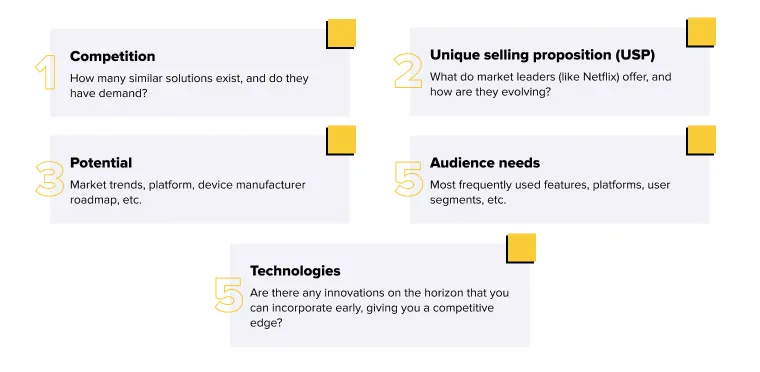
While this is not a comprehensive list of analysis objectives, it demonstrates the importance of this process and provides a foundation for further steps.
Wireframing and Prototyping
Before diving into actual development, test the software's concept and design. This helps reduce risks and budget expenditures in creating the digital product.
Ignoring this step may lead to potential failure in the market.
Defining App Structure and Navigation Flow
The viability of your product relies on how well your software is structured and how navigation logic is organized. For instance, a cumbersome and confusing menu will decrease user experience, leading to customer churn.
Conversely, well-organized navigation with intuitive controls will ensure success among users and even lead to organic promotion.
Creating Interactive Prototypes
Before starting the development process, implement several design variations (simulations) with interactive elements. This helps:
Validate the concept.
Test the navigation.
Present the concept to the public.
Attract investments.
Determine the optimal app template.
This is sufficient to move on to the software development process.
Development and Coding
A key remark for this point: the process is subjective and depends on the platform for which you're developing the software. For example, if you're targeting Samsung Tizen TV, the system is based on Linux, so the technical stack will differ from Android TV or Apple TV.
However, the development principle remains the same for all platforms.
Choosing the Right Technology Stack
First, you must choose technologies—programming language, framework, etc. Base your choices on the platform for which you're developing the software. Prefer a technical stack that allows for efficient scalability without starting from scratch.
Optimize the process in advance to save time, resources, and costs when creating the TV app.
Implementing TV App Features and Functionality
Consider all available features of the devices you're creating the digital solution. Also, be mindful of the platform roadmap (potential future features).
Implement compatibility with embedded features, sensors, technologies, etc., through APIs. Additionally, comprehensively test your product.
Testing and Quality Assurance
The testing process starts at the conceptual stage. Initially, test the idea, then the code, and later, QA supports the IT solution.
QA also allows for proper and efficient app scaling. By analyzing user feedback, market trends, etc., you can plan for further software development. This is essential if you want to monetize the application in the long term.
Ensuring App Performance and Compatibility
Remember that your app will be used on various Smart TV sets with different specifications. Ensuring complete compatibility with all screen sizes and device specifications (at least for the current model range) is critical.
The adaptability of your app will determine the number of users and, consequently, your product's revenue.
Conducting User Acceptance Testing
The best indicator of your app's popularity is user feedback. While testing with interaction templates can be helpful, it won't provide a realistic state of the software.
Only those who use the application daily can pinpoint its real issues and advantages.
So involve your audience in testing, improve the UX based on their feedback, and earn revenue from satisfied customers.
The key is to ensure that the app's core features work correctly from launch while other aspects can be implemented later.
Essential Features for Smart TV Apps
Functionalities of connected TV or Smart TV apps can be divided into several categories:
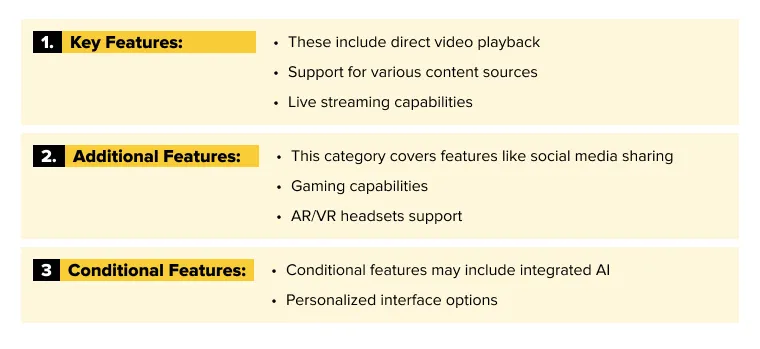
It is important to initially focus on the core functionalities of the product and then add new features as part of the scaling roadmap.
Content Delivery and Streaming
The main task of digital products for televisions is content playback. Movies, shows, news, live broadcasts, blogs, and everything related to video should be implemented at the highest level.
Two types of products (although they can be combined) cater to specific user needs and therefore hold value for particular user categories. Let's examine them in detail.
Video-on-Demand (VoD) Capabilities
Netflix, YouTube (partially), Muvi, and Vimeo are typical examples of Video-on-Demand (VOD) services. These platforms allow users to select and watch the content they desire anytime. The main types of videos available on such platforms include:
Movies
TV Shows
Cartoons
Animated TV Series
Anime
Also, niche content such as blogs or music videos can be categorized under VOD. The key idea of such platforms is to give users access to specific videos whenever they want.
Live Streaming Functionality
YouTube (partially), TikTok, Twitch, and others are typical examples of streaming platforms. These services allow users to access live streams from bloggers, celebrities, and other content creators.
The typical functionality of this type of software includes:
Content viewing
Screen capturing for streaming
Interaction with external devices (microphone, camera, etc.)
Donation system
Sharing channels through social media and content rating
This software model allows users to create or view live streams (and their recordings) while monetizing the content through subscriptions or direct payments.
VOD and streaming services can be combined within a single application (hence why YouTube appears in both categories). However, it is advisable to initially focus on one of them and later expand the features and capabilities of the app for Smart TVs.
Interactive and Engaging Elements
During Smart TV application development, it is beneficial to implement additional functionality, such as interactivity and third-party integration. However, this is not a top priority and can be deferred until a certain stage, for example, until the release of the core features of the software.
While gaming features (who doesn't remember the legendary "Tetris" on LG TVs?) and content sharing via social media are not mandatory, they are desirable functionalities, as well as the option to use the TV as a screen for gaming consoles (with additional advantages).
This applies not only to Smart devices but also to additional equipment, like connected TVs.
Gamification and Interactive Content
The modern entertainment industry offers traditional gaming capabilities on TV and interactive video content. This includes adaptive movie plots, dialogues with variability, and interaction with actors on the screen (Interactive TV).
Furthermore, other interactive features, like voting, quizzes, etc., can be implemented during live broadcasts or through a separate interface.
Despite the complexity of implementing such functionality (which is why we recommend introducing it within the framework of software scalability), it positively impacts user engagement with the program. It enhances monetization opportunities by involving viewers in specific activities.
Social Media Integration
Almost every TV user shares their impressions of movies and shows with friends, family, and colleagues. Integrating social media (with embedded APIs in the software) allows users to post reactions on their profiles and attach them to specific moments from a movie.
Moreover, this can be done right from the app menu without the need to get up from the couch (if such functionality is implemented in the software).
Although this integration is not a mandatory component for a Smart TV application, it is desirable if you intend to develop the product in the long term.
Personalization and Recommendation
If you plan to give users maximum control over content and software functionality, it is advisable to implement additional customization features. For example, integrating AI, adding multi-profile support, interface customization, theme selection, etc.
While not mandatory, these features are desirable, especially if your goal is to support and monetize your product over an extended period.
Such components increase user engagement with the application, but their implementation may require additional costs. However, focusing on long-term development can be a good investment, leading to a corresponding return on investment (ROI).
Customizable User Profiles
Typically, families consist of 3-5 people living together, each using TV to view specific content.
For instance, the younger age group, children or teenagers, may prefer cartoons and anime.
The middle group, young adults, may prefer movies, TV shows, and sometimes thematic programs.
The older age category focuses on retro movies, news, TV shows, etc.
Multiple user profiles can be used to facilitate the search for thematic content and personalize recommendations. Each user can individually configure their preferences.
AI-Based Content Recommendations
The trend of integrating AI is gaining momentum, and it's already a clear perspective that sets the direction for the further development of the IT industry, including TV app development.
With AI, users can quickly personalize content suggestions and customize the software according to their priorities.
One important note: implementing such interfaces and features in an MVP (Minimum Viable Product) doesn't make much sense unless AI is your product's unique selling point (USP). This potential investment is beneficial in the long term, considering that you may have other, more niche tasks in the initial development stages.
TV App Development for Different Platforms
The complexity and cost of Smart TV development mostly do not depend on the platform you initially focus on. Over time, additional expenses may be required for adapting the software to third-party operating systems when expanding the scope.
However, in the initial stage, try to explore the potential of the key platform and concentrate on its implementation in the digital product.
The experts at Lampa Software have prepared a brief overview of the main operating systems installed on Smart TVs and the peculiarities of app development for them.
Fire TV App Development
Fire TV app development covers a range of devices within the Amazon ecosystem. It typically involves using Amazon Fire TV SDK in combination with Adobe Xcode or Android Studio and programming languages like Java, Kotlin, C++, etc.
The main priorities are the user interface, functionality, and adaptability. An additional focus is on compatibility between system devices and performance.
Samsung TV Development
Samsung TV app development is designed for releasing applications for the Tizen OS ecosystem, using Samsung Tizen SDK or third-party frameworks. As the system operates on Linux, it allows for implementing various types of software, unlike Fire apps, where the potential is relatively limited.
Like other platforms, the main emphasis is on adaptive interface and functionality. Additionally, focus on scalability and integrations.
Apple TV App Development
Apple TV app development is both simple and complex. It is simple because the ecosystem is limited and complex because it requires a comprehensive approach.
Considering the needs of Smart TV users on this platform, you need to focus on the interface and functionality. Also, on performance, more precisely, integrating the product into the Apple ecosystem to ensure the app works seamlessly.
Sony Smart TV App Development
Regarding Sony Smart TV app development, it is relatively standard. The software is developed for the Google TV OS, which is a fork of Android, so it uses a basic toolkit.
The standard priorities are the interface, adaptability, and functionality. Additional focus on interactivity and integrations.
Android TV App Development
Android TV application development is not much different from the process for the mobile version of the OS. However, the emphasis here is on the specific aspects of the devices, such as adaptive interface and support for a wide range of hardware.
As various TV manufacturers use the OS, you should consider the entire main range of specifications. For example, screen sizes, types of matrices, and processors.
Ultimately, the more devices your application can cover, the better you can monetize it.
Monetization Strategies for Smart TV Apps
Now, we have come to the topic that interests everyone planning to develop their own app for showcasing TV shows or other content. Monetization is the way you can not only recoup the development costs but also attract even more revenue.
Looking at Netflix's experience, a company that earned over $31 billion in revenue in 2022, we can understand how profitable VOD platform development can be.
And don't listen to those who say the niche is occupied and lacks prospects. The industry still has enough potential to welcome new players with unique concepts and their implementation.
The key is to choose and combine the right monetization methods, marketing strategies, and the technical foundation of the software.
Subscription Models
A modern trend is the subscription model, which includes the cost of developing Smart TV apps and factors such as QA and scalability.
This model is applied everywhere: in programs, games, operating systems, services, e-commerce, etc.
Therefore, it is perhaps the best way of monetization. It includes two subtypes.
Premium Content Access
This involves subscribing to extended features and content. A similar model is used by YouTube, providing free access to content but with some restrictions, such as aggressive ads in videos or disabled functionality.
On the one hand, the restrictions are not significant, but on the other hand, they passively push the user to purchase premium features.
In the context of VOD, we distinguish two subcategories: SVOD and TVOD. The former allows viewing all content with a paid subscription, while the latter allows users to pay only for access to specific movies or series. Similarly, in streaming services, bloggers or celebrities can conduct paid broadcasts.
Ad-Free Experience
AVOD is one of the best monetization models. On the one hand, as the owner, you receive commissions for displaying ads in the app; on the other hand, you offer an ad-free experience to premium subscribers.
Again, we can refer to YouTube, which monetizes through both ads and the option to disable them through a Premium purchase (which, by the way, limited the opportunities for third-party IT solutions for the platform).
AVOD, SVOD, and TVOD models can be used simultaneously, forming a "Hybrid" approach—a combination of different monetization solutions harmoniously integrated into one system.
Now, let's see how to generate revenue from removing ads for users and explore marketing methods for earnings in "freemium" apps.
In-App Advertising
Advertising is the most effective way to promote services or products and monetize IT products. Just imagine if advertising couldn't compensate for the development cost of "freemium" apps; the process would be unprofitable.
However, you should not integrate marketing blocks into the app without a thoughtful strategy, hoping they will bring income. On the contrary, all the efforts toward monetization can be negated without a smart approach.
The experts at Lampa Software have analyzed the potential of advertising revenue in Smart TV products and prepared a brief overview of this type of monetization.
Targeted Advertising Opportunities
Segmenting the target audience for marketing is a key task for effective promotion and the only right way to show relevant content to the audience. Depending on the type of monetization (ads based on clicks, views, or impressions), creatives can either work or not. In the first case, the marketing goal will be achieved, and you will earn commissions; in the second case, you may lose your audience.
Ad blocks should be implemented to adapt to the user's region, gender, age, and interests and show only relevant content.
Ad Placement Considerations
If ads cover the content, users are unlikely to rush to pay for premium access to the app. Instead, they might switch to another app where marketing blocks are present but do not interfere with the viewing experience.
Place advertising positions wisely: in the corners, at the bottom, top, or side of the screen, but not covering the content.
This way, users will see the creatives, but they won't be too intrusive, which increases the chances that they will take the desired action or at least not delete the app.
Sponsorships and Partnerships
You can use partner programs that offer to place targeted content in your app in exchange for commissions. However, you should be cautious and avoid excessive use of gambling-related creatives, 18+, etc. Some marketing blocks can also be integrated directly into the content, such as periodic video ads (up to 30 seconds) at the beginning, end, or during a broadcast.
Collaborating with Brands and Content Providers
Sometimes you can broadcast content, conditional movies, or series for free if you comply with certain conditions. For example, you may show sponsored ads, overlay specific text on the screen, etc. This is one of the most common ways of advertising monetization, and it is not too intrusive.
Integration of Sponsored Content
Even if you decide to use sponsor or partner programs, make sure you can meet their requirements. For example, broadcasting videos with a certain periodicity or placing them in specific locations.
Too aggressive and intrusive advertising that disrupts content viewing won't improve the effectiveness of monetization. It will only create additional challenges for your app, which may negatively affect its future in the niche.
Challenges and Future Trends in Smart TV App Development
In conclusion, we want to draw your attention to a few more points regarding Smart TV software development. Despite all the advantages and monetization possibilities mentioned, developing software for Smart TVs is not as easy as it may seem at first glance.
Let's briefly overview the key challenges of this segment and its future potential.
Fragmented Market and Platform Compatibility
As you already understand, the Smart TV niche is quite diverse, with several corporations competing for leadership. Hence, there are multiple platforms to distribute your IT solution.
However, it's not all bad as it may seem. Most of the current operating systems are based on Android or Linux (or iOS in some cases), making development quite similar.
The main challenge lies in the variability of device specifications. Therefore, the primary focus should be on the adaptiveness of design, interface, and software performance on the latest TV models.
Privacy and Data Security Concerns
In any case, applications access user data: payment information, region, personal information, etc. Make sure that none of this data goes beyond the system and falls into the hands of malicious actors.
Implement encryption in your software and enable two-factor authentication for transactions, among other security measures.
Voice and Gesture Control Advancements
Do not limit yourself to device algorithms when developing control systems for your software. Technology is rapidly evolving, creating new methods of interaction with devices.
Consider this while developing your TV application and proactively lay the groundwork for integrating future innovations.
Integration with Smart Home Devices
Although IoT is not yet widespread among users, this trend is gaining momentum, offering new systems for interacting and controlling smart devices. Plan ahead so that your application can also work with these new technologies.
This will save you time and resources and provide a competitive advantage.
Conclusion
In summary, let's reiterate the key points of the discussion:
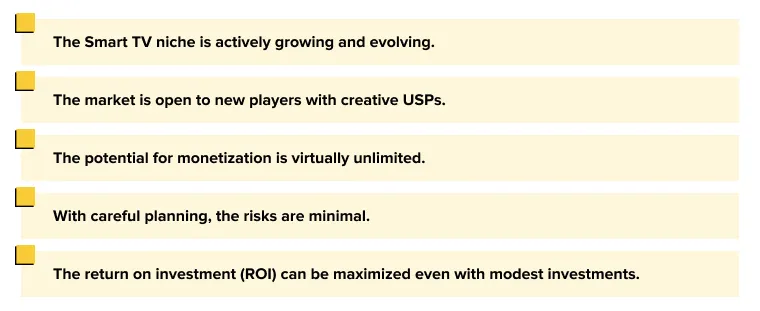
Therefore, 2023 is a golden period to launch your own project on Smart TV.
Regardless of which platform you choose to start with or how quickly you plan to develop your product, the experts at Lampa Software will support you. Delegate your project to us and get the most out of what we can offer.
From analysis and roadmap formation to development, quality assurance, software support, and scalability – we offer a full range of Smart TV App development services that will help you quickly debut in the market and effectively monetize your project!